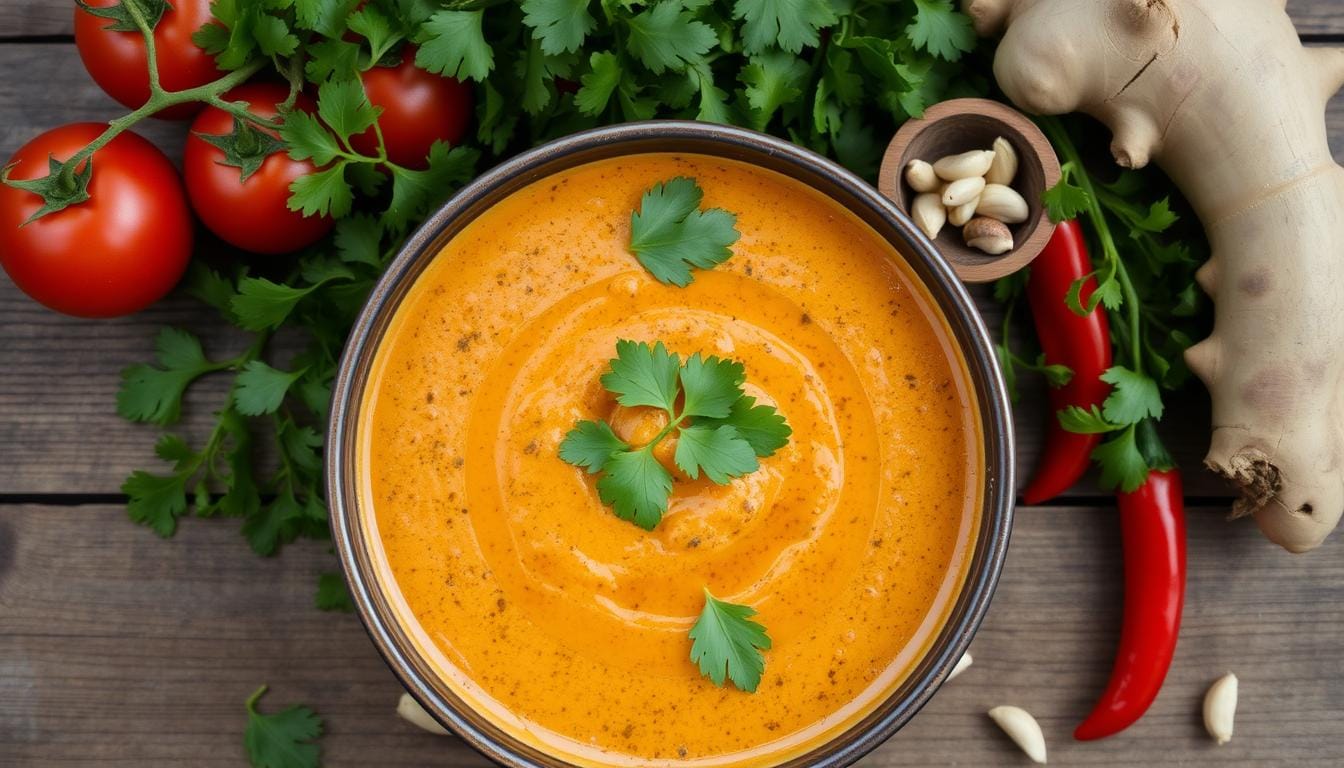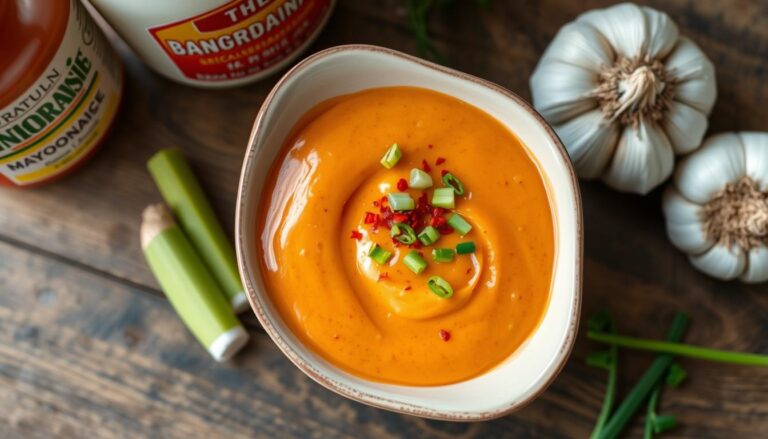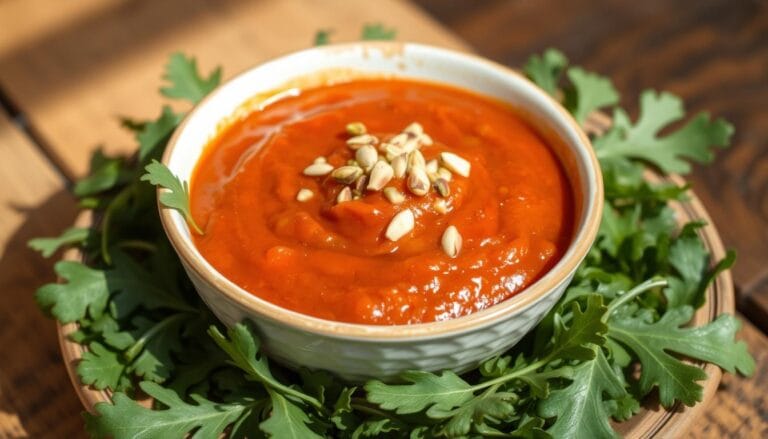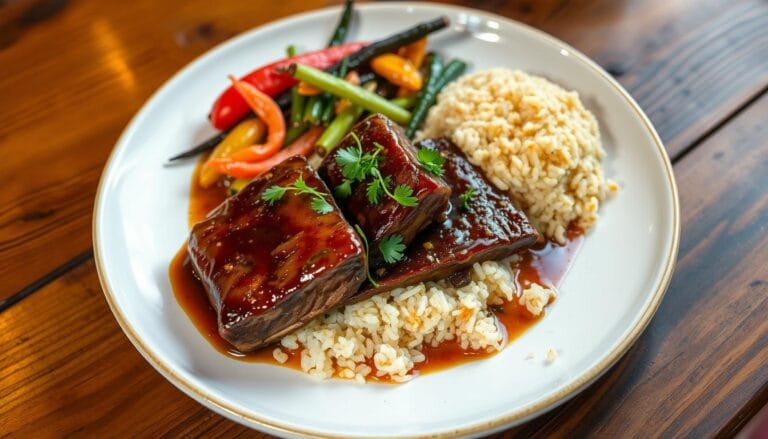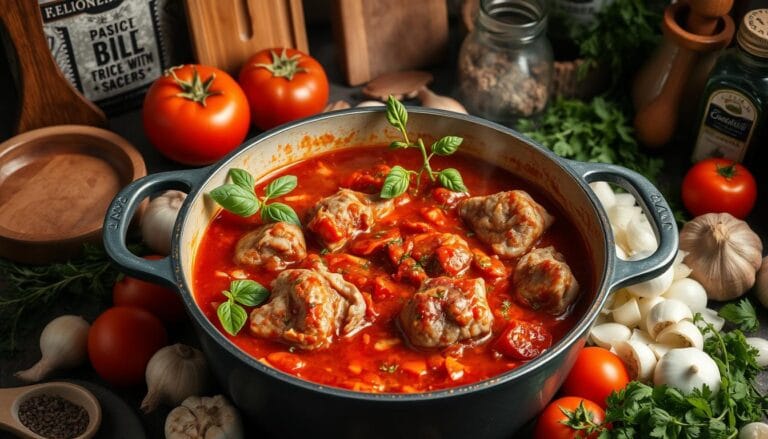Make Easy Jhol Like Sauce Recipe at Home
As the sun set, it brought back memories of my childhood in a Bengali village. The smell of spices and the sound of oil crackling reminded me of my grandmother’s jhol. This light, flavorful curry could comfort anyone. I found a quick and easy way to make it at home.
The secret is in the right mix of spices, fresh ingredients, and simple techniques. These come together to make a easy jhol like sauce. It’s perfect for many delicious meals. This recipe is great for both experienced cooks and beginners in Bengali cuisine.
Table of Contents
Understanding the Traditional Bengali Jhol Sauce
At the heart of traditional Bengali cuisine is the jhol. It’s a thin, broth-like curry that celebrates fresh, seasonal ingredients. It’s made with winter vegetables like cauliflower, broad beans, and potatoes.
Origins and Cultural Significance
The origins of jhol go back to Bengal’s rich culinary traditions. It’s a staple in rural homes. Jhol’s simplicity lets the natural flavors of ingredients shine, without overpowering spices.
Key Characteristics of Authentic Jhol
Authentic jhol is known for its thin, broth-like texture. This lets the subtle spices and fresh produce stand out. Unlike thick South Asian curries, jhol has a delicate flavor balance. It often uses aromatic nigella seeds for its unique taste.
Regional Variations Across South Asia
While the traditional Bengali jhol is the base, South Asia has its own versions. Some use a cumin-cardamom-cinnamon mix instead of nigella seeds. This shows the diverse culinary traditions of the subcontinent.
Essential Ingredients for Your Jhol Sauce
To make a true jhol sauce at home, you need a mix of Indian spices and fresh produce. The main ingredients for this traditional Bengali dish are:
- Mustard oil – a key cooking oil in South Asian cuisine
- Cumin seeds and bay leaf for a deep aroma
- Onions, garlic, and ginger – the flavor trio
- Tomatoes for a tangy taste and thickness
- Turmeric, cumin powder, coriander powder, and garam masala – the spice mix
- Red chili powder for heat and depth
To make it even more authentic, add dal’er bori (sun-dried lentil dumplings) and Bengali garam masala. Also, use fresh veggies like cauliflower, potatoes, and green chilies in your jhol.
“The secret to a delicious jhol sauce lies in the perfect balance of spices and fresh ingredients.”
Using top-quality Indian spices and fresh produce will make your jhol sauce taste amazing and authentic.
Kitchen Tools and Equipment Needed
To make a delicious jhol (sauce) at home, you need the right tools. Traditional Bengali cooking uses a round-bottomed aluminum kadai (wok) and a metallic khunti (stirring spoon). But, you can also use a deep frying pan or a Dutch oven for great results.
Traditional vs Modern Cooking Vessels
The kadai is great for even heat, cooking spices and ingredients perfectly. But, a heavy-duty skillet or Dutch oven works well too. They offer good heat control and even cooking. Choose a vessel with a thick bottom for consistent temperature.
Recommended Utensils for Best Results
- A sharp chef’s knife for quick veggie prep
- A fine-mesh strainer for the right sauce texture
- A wooden spoon or stainless steel ladle for stirring and serving
- A measuring cup and spoons for exact ingredient amounts
- A mortar and pestle for grinding spices and making pastes
With the right Indian cooking utensils, traditional cookware, and modern kitchen tools, you can make a tasty jhol sauce at home.
Easy Jhol Like Sauce Recipe: Step-by-Step Guide
Making a tasty jhol sauce at home is simpler than you think. Just follow these easy steps to make a sauce that will make your Indian dishes better. Let’s get started:
- First, heat a tablespoon of oil in a saucepan. Add whole spices like cinnamon, cardamom, and bay leaves when the oil is hot. Cook them until they smell great, about 30 seconds to a minute.
- Then, add chopped onions to the pan. Cook them until they’re golden brown, which takes about 5-7 minutes. This step is key for the sauce’s flavor.
- After the onions are done, add minced garlic and grated ginger. Cook for another minute, until the smell fills the air.
- Next, add diced tomatoes to the pan. Let them cook until they’re soft, about 5-7 minutes.
- Now, add ground spices like turmeric, chili powder, coriander, and cumin. Season with salt to taste. Cook for 2-3 minutes, stirring often, until the oil separates from the mixture.
- Slowly add water, starting with 1/2 cup. Adjust the thickness to your liking. Simmer the sauce gently for 5-7 minutes, letting the flavors mix well.
- Finally, stir in garam masala and fresh cilantro. Your jhol-like sauce is now ready to use or serve.
This whole process takes about 20 minutes. You’ll get a flavorful sauce that’s great for many dishes. Try it with different proteins, veggies, or as a dipping sauce. The options are endless!
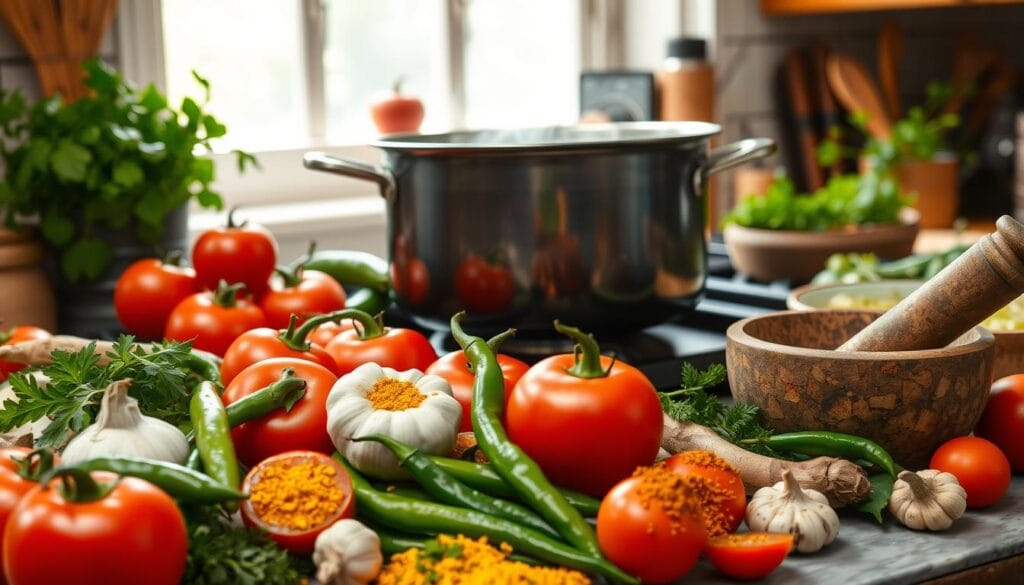
“The key to a truly authentic jhol sauce is in the careful balance of spices and the slow simmering process that allows the flavors to meld together seamlessly.”
Mastering the Art of Tempering Spices
Tempering spices is key to making your jhol sauce flavorful. It involves heating oil and adding spices to release their scents. This makes your dish taste complex and layered. Learning to temper spices well can make your homemade jhol sauce amazing.
Common Tempering Mistakes to Avoid
One big mistake is burning the spices. If the oil gets too hot, the spices can turn bitter. Keep an eye on the oil’s temperature and when you add the spices.
Timing and Temperature Control
Heat the oil until it shimmers but doesn’t smoke. This is usually between 320°F and 350°F. Then, add spices like cumin seeds or a mix of Indian spices. Let them sizzle for 30 seconds to 1 minute, without burning.
By controlling the timing and temperature, you can bring out the spices’ full flavor. This will make your jhol sauce even better.
| Spice Blend | Flavor Profile | Recommended Uses |
|---|---|---|
| Cumin-Cardamom-Cinnamon | Warm, earthy, and slightly sweet | Curries, rice dishes, lentil-based preparations |
| Nigella Seeds (Kalonji) | Pungent, slightly bitter, and slightly nutty | Traditional tempering for jhol sauces and dals |
| Mustard Seeds and Curry Leaves | Pungent, slightly bitter, and earthy | Vegetable dishes, pickles, and chutneys |
Proper tempering is the hallmark of a well-executed Indian curry. It’s the finishing touch that brings all the flavors together in harmony.
Mastering spice tempering lets you add a rich flavor to your jhol sauce. It takes your taste buds on a journey through India’s vibrant flavors.
Customizing Your Jhol Sauce Base
Explore a world of flavors by tweaking your jhol sauce base. Try adding different veggies, proteins, or spice mixes to make it your own. For a creamier sauce, add coconut milk. Or, for a tangy flavor, use tamarind paste.
For a richer sauce, blend soaked cashews or almonds into a paste. Then, stir it into the base. You can also adjust the heat by changing the chili powder or adding green chilies.
Jhol sauce is all about creativity. Mix and match flavors to make it your own. Whether you like it mild or spicy, you can customize it to your liking.
Vegetable Variations
- Sautéed eggplant or potatoes for a heartier texture
- Chopped tomatoes or bell peppers for a vibrant pop of color
- Finely diced onions or garlic for a deeper, more aromatic base
Protein-Packed Options
- Cooked shrimp or fish for a seafood-infused jhol
- Seared chicken or paneer cubes for a protein-rich sauce
- Boiled eggs or lentils for a vegetarian-friendly variation
Spice Blend Experimentation
| Spice | Flavor Profile | Suggested Amount |
|---|---|---|
| Cumin | Earthy, warm | 1-2 teaspoons |
| Coriander | Citrusy, slightly sweet | 1-2 teaspoons |
| Ginger | Pungent, slightly spicy | 1-2 tablespoons, grated |
| Chili Powder | Fiery, bold | 1/2 – 1 teaspoon |
Play with these spices to find your perfect flavor. The options are endless for customizing your jhol sauce base!
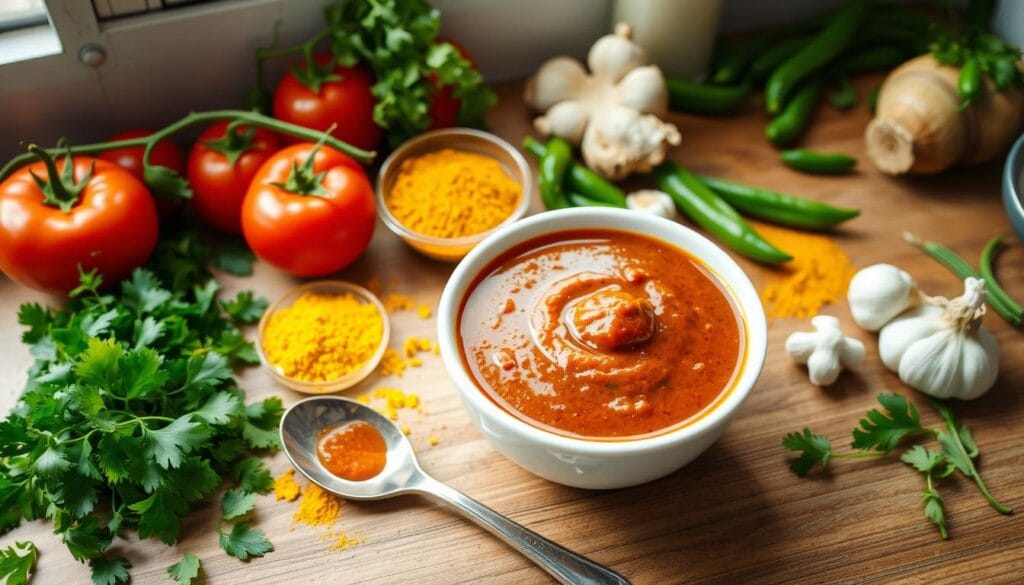
Versatile Ways to Use Your Jhol Sauce
Jhol sauce is a flavorful condiment that can make many dishes better. It’s great with different proteins or as a base for vegetarian and vegan dishes. This sauce is a true culinary chameleon.
Pairing with Different Proteins
The tangy and slightly spicy Jhol sauce goes well with many proteins. Try it with grilled or pan-seared fish like tilapia or salmon for a tasty seafood dish. It also pairs well with chicken, making it succulent and aromatic.
For a vegetarian option, Jhol sauce is great with paneer (Indian cottage cheese) or tofu. It makes them a perfect canvas for this flavorful sauce.
Vegetarian and Vegan Applications
- Roasted Vegetables: Drizzle Jhol sauce over roasted cauliflower, potatoes, or eggplant for a delicious and nutritious side dish.
- Lentil or Chickpea Curries: Use the Jhol sauce as a base for hearty vegetarian or vegan curries, adding depth and complexity to the dish.
- Rice and Naan Pairing: Serve the Jhol sauce over a bed of fluffy basmati rice or alongside warm naan bread for a complete and satisfying vegetarian or vegan meal.
Jhol sauce’s versatility lets you try many curry pairings, vegetarian recipes, and vegan curry options. It’s a valuable addition to your kitchen.
| Protein | Vegetarian/Vegan Option | Suggested Pairing |
|---|---|---|
| Fish | – | Grilled or pan-seared tilapia or salmon |
| Chicken | – | Boneless or bone-in chicken |
| Paneer | Tofu | Cubed or grilled |
| – | Cauliflower, Potatoes, Eggplant | Roasted vegetables |
| – | Lentils, Chickpeas | Vegetarian or vegan curries |
“The versatility of Jhol sauce allows you to explore a wide range of curry pairings, vegetarian recipes, and vegan curry options, making it a valuable addition to your culinary arsenal.”
Storage Tips and Meal Prep Suggestions
To keep your homemade jhol sauce tasty, proper storage is crucial. Store leftovers in an airtight container in the fridge for up to three days. For longer storage, freeze it in containers or ice cube trays for up to three months. When you thaw it, add a bit of water to get the right consistency.
This versatile jhol sauce makes meal planning easy. Use it as a base for quick meals by adding cooked proteins or veggies. You can customize your dishes to fit your taste and diet.
It’s important to follow food safety when handling jhol sauce. Refrigerate or freeze it right after cooking. Reheat it well before serving. By storing it right and using it in meal prep, you can enjoy jhol’s rich flavors whenever you want.
